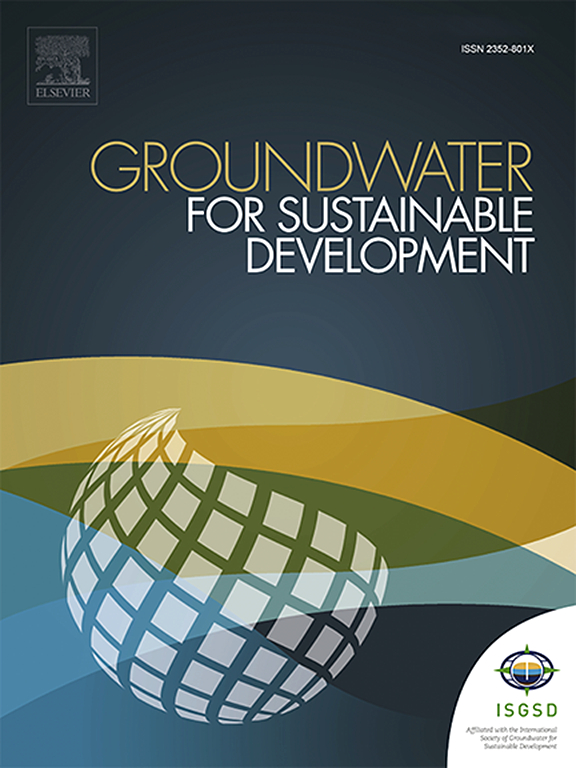含水层脆弱性和水质评价:基于地下水流量来源的回归分析验证
IF 4.9
Q2 ENGINEERING, ENVIRONMENTAL
引用次数: 0
摘要
Puebla Valley含水层(PV)是位于墨西哥中部的一个火山沉积系统,由于土地利用变化和地下水污染,它面临着越来越大的压力。但是,它的脆弱性尚未得到全面评估。本文采用适应火山沉积环境特征的DRASTIC方法评价了PV含水层的内在脆弱性,并基于地下水流量的来源,将其与水质指数(WQI)和污染指数(Cd)进行了简单的线性回归分析,对结果进行了验证。在考虑土地利用变化(补给区、农业区和城区)的基础上,通过修改参数权重来调整DRASTIC模型以反映当地含水层条件。线性回归显示脆弱性与WQI之间存在显著相关(p<0.001);对于内华达山脉的流量,这两个变量之间的拟合度为84%,而La Malinche的拟合度为83%。确定阿托亚克河为主要污染源,周边地区WQI极值为35(水质差),Cd>3(高健康风险)。DRASTIC方法将550平方公里(25%)划分为低脆弱性,800平方公里(36%)为中等脆弱性,690平方公里(31%)为高脆弱性。影响最大的因子是补给量(临界带350 mm/年)、地下水位深度(7 m)和地形坡度(5%)。这些结果首次验证了基于流源回归的DRASTIC方法在火山沉积含水层中的适用性。他们强调有必要紧急保护补给区并调节向阿托亚克河的排放。该方法为在半湿润环境下的可持续管理提供了工具,但在人为活动下。本文章由计算机程序翻译,如有差异,请以英文原文为准。

Assessment of aquifer vulnerability and water quality: Validated using groundwater flow origin-based regression analysis
The Puebla Valley aquifer (PV), a volcanosedimentary system located in central Mexico, faces increasing pressure due to land use change and groundwater contamination. However, its vulnerability had not been comprehensively assessed. This study aimed to evaluate the intrinsic vulnerability of the PV aquifer using the DRASTIC methodology adapted to the characteristics of a volcanosedimentary environment and validate the results using simple linear regression analysis based on the origin of groundwater flows, correlating them with water quality indices (WQI) and contamination indices (C).
The DRASTIC model was adjusted by modifying parameter weights to reflect local aquifer conditions, considering land use change (recharge, agricultural and urban zones) as the basis. Linear regression showed significant correlations (p0.001) between vulnerability and WQI; for flows from Sierra Nevada, an 84% fit was found between these two variables, and 83% for La Malinche. The Atoyac River was identified as the main contamination source, with extreme values of WQI=35 (poor quality) and C (high health risk) in adjacent areas.
DRASTIC classified 550 km (25% of the area) as low vulnerability, 800 km (36%) as moderate, and 690 km (31%) as high. The most influential factors were recharge ( mm/year in critical zones), water table depth (7 m) and topographic gradient (5%).
These results validate for the first time a DRASTIC adapted with flow-origin-based regression for volcanosedimentary aquifers. They emphasize the need to: urgently protect recharge zones and regulate discharges into the Atoyac River. The methodology provides tools for sustainable management in subhumid environments, but under anthropogenic activities.
求助全文
通过发布文献求助,成功后即可免费获取论文全文。
去求助
来源期刊

Groundwater for Sustainable Development
Social Sciences-Geography, Planning and Development
CiteScore
11.50
自引率
10.20%
发文量
152
期刊介绍:
Groundwater for Sustainable Development is directed to different stakeholders and professionals, including government and non-governmental organizations, international funding agencies, universities, public water institutions, public health and other public/private sector professionals, and other relevant institutions. It is aimed at professionals, academics and students in the fields of disciplines such as: groundwater and its connection to surface hydrology and environment, soil sciences, engineering, ecology, microbiology, atmospheric sciences, analytical chemistry, hydro-engineering, water technology, environmental ethics, economics, public health, policy, as well as social sciences, legal disciplines, or any other area connected with water issues. The objectives of this journal are to facilitate: • The improvement of effective and sustainable management of water resources across the globe. • The improvement of human access to groundwater resources in adequate quantity and good quality. • The meeting of the increasing demand for drinking and irrigation water needed for food security to contribute to a social and economically sound human development. • The creation of a global inter- and multidisciplinary platform and forum to improve our understanding of groundwater resources and to advocate their effective and sustainable management and protection against contamination. • Interdisciplinary information exchange and to stimulate scientific research in the fields of groundwater related sciences and social and health sciences required to achieve the United Nations Millennium Development Goals for sustainable development.
 求助内容:
求助内容: 应助结果提醒方式:
应助结果提醒方式:


